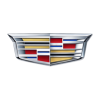
2019 Cadillac CTS-V


Key Specifications for 2019 Cadillac CTS-V






Buyer’s Guide
If you want to know what the future of Cadillac's high-performance models looks like, well, your guess is as good as ours.
That's because this car, the most potent and driver-focused version of Cadillac's mid-size CTS, is due to disappear soon to make room for a new mid-priced sedan that will replace both this car and the compact ATS.
Aside from that forthcoming car -- to be called the CT5 -- and the larger CT6, Cadillac's lineup with be mostly made up of SUVs and crossovers, so there's a distinct possibility this brand may steer its performance aspirations in a direction similar to BMW's efforts with its X5M and X6M mid-size crossovers.
For now, however, the CTS-V carries on into 2019 with no changes. This is Cadillac’s most extreme sport sedan, with a 6.2L supercharged V8 that cranks out 640 hp and 630 lb-ft of torque and a pedigree shared with the brand’s DPi-V.R endurance race car.
The CTS-V retains its roughly four-second 0-100 km/h sprint and 322 km/h top speed, performance metrics that come courtesy that big engine and the eight-speed automatic it’s bolted to.
This is one of the few high-performance sport sedans with rear-wheel drive, a setup some enthusiasts will tell you preserves the purity of steering feel that enhances the high-speed driving these cars were built for. BMW’s latest M5 now has AWD, as do the Mercedes-AMG E 63 S and, naturally, the Audi RS 7. There’s an argument to be made that AWD is a wise addition to a 600-hp-plus car as two wheels can only do so much when asked to put that much power to the road.
When you want to test the CTS-V's traction, engage the launch control mode for maximum acceleration from a stop, toggle the sport drive mode and choose your favourite setting from the five-mode traction management system. A performance data recorder lets you capture real-time video, cabin audio and performance data to analyze your track driving performance, and a magnetic ride control suspension is here to help the car’s suspension react as quickly as possible to changing conditions on road or track. In other words, Cadillac is not messing around, here.
A hood made of carbon fibre is standard, and the CTS-V can be further equipped with carbon fibre for the front splitter, hood vent, rear spoiler and rear diffuser for better aerodynamics, while Brembo brakes provide capability for track-day performance straight from the factory.
The CTS-V is not all about speed, though. Apple users who have the myCadillac app will be able to sync the app with an Apple Watch to do things like locate the car and get walking directions to it, start the engine remotely, lock/unlock doors and activate lights. There's also a standard heated steering wheel that turns on automatically at low temperatures.
In case you’re worried about such things when you’re bombing around your favourite local racetrack, the CTS-V’s fuel consumption estimates are 16.5/11.1 L/100 km in city and highway driving, respectively.
Photos






























AutoTrader Review


This vehicle has not yet been reviewed
















